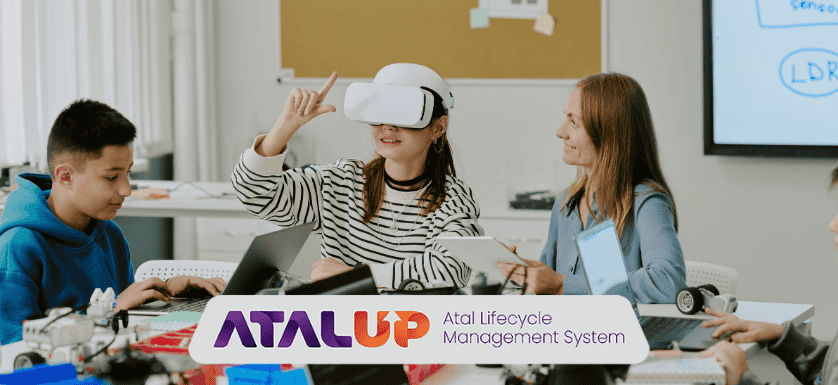
Kids nowadays are deeply involved in smartphones. Be it watching funny videos or playing games; our young learners are getting addicted to smartphones. The government of India looks from another perspective. It has focused on – how to learn game development in schools. Atal Innovation Mission along with NITI Aayog introduced Atal Tinkering Labs in 2016. 10,000 schools have received ATLs and our young learners are performing well.
What is Atal Tinkering Lab?
Atal Tinkering Labs (ATLs) are innovation spaces set up in schools by the Indian government under the Atal Innovation Mission. These labs allow students to explore STEM subjects through hands-on experiments using real tools like 3D printers, robotics kits, sensors, and much more.
How to Learn Game Development in Atal Tinkering Labs?
One exciting addition to the ATL experience is the game development module. It helps students explore game programming and learn how games are made, designed, and coded. This not only boosts problem-solving but also introduces kids to real career opportunities in the gaming industry. The average game developer salary in India is 8 to 13 LPA for 3+ years of experience. You can gauge the demand for these skills.
Hence, our government has collaborated with DELL and the Learning Links Foundation to help school students learn game programming.
The PlanetCode Initiative
PlanetCode is a collaborative initiative launched by Dell Technologies, the Learning Links Foundation, and the Atal Innovation Mission (AIM) under the NITI Aayog. It is built to support the goals of the Atal Tinkering Lab (ATL) program, by helping students go beyond theory and learn 21st-century tech skills through structured, project-based learning.
The platform focuses on giving students free access to emerging technologies, especially in areas like game development, artificial intelligence, mobile apps, IoT, and AR/VR. It is aligned with multiple UN Sustainable Development Goals (SDGs) and encourages purpose-driven innovation.
What makes PlanetCode unique is:
Curriculum designed for ATL learners, Each course is simple, visual, and hands-on, tailored for middle and high school students.
Real-world learning tools, Students use platforms like Google’s Teachable Machine, Tinkercad, Hatch Kids, Weebly, and more.
Outcomes beyond marks, The goal is not just to learn, but to apply. Students complete projects, build portfolios, and present ideas that solve real problems.
Equal access for all, The courses are available across all states in India, making futuristic education inclusive and accessible.
Teacher and student support, The platform also equips ATL-in-charges and educators with easy-to-implement resources and guides.
PlanetCode ensures students don’t just ask “how to learn game development” or “what is AI,” but actually start building apps, games, websites, and smart solutions from day one.
Courses Offered by PlanetCode Under Game Programming
PlanetCode offers six hands-on, beginner-friendly courses designed to help students explore new technologies in a fun and practical way. These courses are aligned with the United Nations Sustainable Development Goals (SDGs), making learning meaningful and purpose-driven.
1. Virtual Reality & Augmented Reality
Students learn how AR and VR work and how these technologies create immersive digital experiences. They get to design their own interactive content using a simple tool called Hatch Kids Platform. The course also highlights how AR/VR can be used to spread awareness about ocean life and environmental issues, linking learning to SDG 14: Life Below Water.

2. Artificial Intelligence
This course introduces students to terms like machine learning, neural networks, and deep learning. They explore real AI tools such as Google’s Teachable Machine and Dancing with AI, building basic AI models on their own. The course focuses on making students creators of AI, not just users, and supports SDG 4: Quality Education.
3. Embedded Systems
Students understand the key parts of embedded systems and learn how to design and simulate simple circuits using the Tinkercad platform. They explore real-life applications like sensors, microcontrollers, and programmable devices, linking their learning to SDG 12: Responsible Consumption and Production.
4. Internet of Things (IoT)
This course teaches how IoT devices work and how they’re changing the world around us. Students use tools like Node MCU module and Arduino IoT Cloud to build simple projects. The course shows how IoT supports SDG 9: Industry, Innovation, and Infrastructure by solving everyday problems using smart devices.
5. Mobile App Development
Students learn what goes into building a mobile app, from structure to features. Using a no-code tool called Thunkable, they design basic apps without writing complex code. This course promotes digital creativity while aligning with SDG 8: Decent Work and Economic Growth.
6. Web Design
This course walks students through the elements of good website design. Using Weebly, they build their own websites without learning a programming language. It introduces UI/UX basics and empowers students to showcase their work online, again, linked to SDG 8: Decent Work and Economic Growth.
How ATALUP Helps Schools Execute Initiatives Like PlanetCode
How to learn game development with ATALUP? Setting up an ATL and adopting programs like PlanetCode requires clear documentation, setup, training, and ongoing support. That’s where ATALUP helps.
ATALUP supports schools in:
- Checking eligibility for the ₹20 lakh ATL grant
- Submitting proper documentation
- Setting up labs with the right equipment
- Training ATL teachers
- Automating lab calendars and reporting
- Supporting implementation of coding modules like PlanetCode
With ATALUP, your school can not only get the grant but also bring futuristic learning, like game development and AI, into your classrooms with ease.
Our forms are open!!!